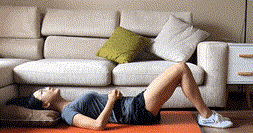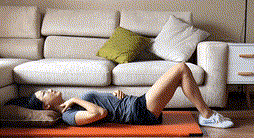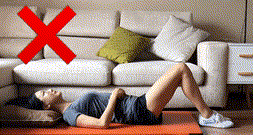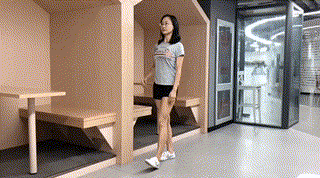Staring down at your phone and monitor all day long, how is your neck?
If you always sit and work, you can take this test, the score can predict whether you will have neck pain in the next year [1]:
Record the score for each question (never = 0 points, rarely = 1 point, sometimes = 2 points, often = 3 points, always = 4 points) for the frequency of responses that meet the following descriptions:
1. The sitting posture during work is as shown in the figure below;
2. In addition to lunch breaks, you can also take breaks during work;
3. Can continue to sit and work despite neck pain;
4. When neck pain occurs at work, the neck will be flexed forward, extended or laterally flexed to relieve symptoms;
5. Stretch the neck muscles;
6. Do exercises to strengthen the strength and endurance of the neck muscles.

Neck upright, back straight against the back of the chair | References [1]
The total score of the test (0-24) is obtained by adding the scores of the 6 items. The higher the total score, the better. If the score is lower than 9, the possibility of neck pain within one year is 88.1%; if the total score is lower than 6, almost You can be sure that neck pain will come to you.
Sitting “upright” cannot rely on others,
to find the feeling
If the score is very low, don’t panic. Changing items 1, 5, and 6 in the question to “always” can significantly reduce the possibility of neck pain [2-5].
The first item is the easiest to say, find someone to stand on the side to give pointers, and you can quickly get into the correct sitting posture. After a few minutes, however, most people return to hunched heads. Relying on others to remind you is not the solution. Only when you find the feeling of sitting upright can you adjust it anytime and anywhere.
It is easier to straighten your body when lying down than sitting. Start with the supine position to find the “right” feeling.
The following exercises are only for healthy people. Those who suffer from related diseases should follow the doctor’s advice. Especially neck pain accompanied by dizziness, blurred vision, limb weakness, paresthesia, fever and other symptoms.

Lie on the pillow, so that the line connecting the forehead and chin, and the line connecting the tragus and the neck are basically parallel to the ground, and step on the ground; bend the lower back forward and back, find the middle position (the trunk is stretched to the longest) and maintain it丨Author Photo courtesy

In this posture, the tongue is against the palate, the lips are closed, and the teeth are slightly separated; pull the chin to the ground (squeeze out the double chin), elongate the neck, and at the same time avoid the protruding muscles of the front of the neck (hand touch position)丨Author Photo courtesy

Don’t make mistakes like raising your chin or raising your head丨Photo courtesy of the author
This feeling of elongation in the torso and neck usually indicates that the body is “right”. After getting familiar with it, try to repeat the “positive” feeling in sitting and standing postures, confirm your posture in front of the mirror, and remember it firmly [6, 7].

Straighten your posture when standing丨Photo courtesy of the author
Prevention, starting with the most commonly used postures
After finding the “positive” feeling, try to maintain this feeling no matter what posture you do or what you do [8].
The position that was maintained the longest each day was usually item 1 on the test – sitting at a desk staring at a monitor. In addition to maintaining the above posture, when leaning on the back of the chair, try to keep the monitor as close to eye level as possible, with your arms supported on the armrest of the chair or on the desktop. If you have the conditions to stand up more and increase the score of item 2, it is of course better.
The second longest thing is sleep. Whether lying on your back or on your side, ensure that the height of the pillow keeps the head and neck in line with the spine.
In addition, the time spent using mobile phones every day is also very long. No matter standing, sitting or lying down, don’t lower your head when looking at your phone. When talking on the phone, don’t hold the phone between your ears and shoulders. If you talk for a long time, it is best to use a headset or a hands-free function.
In addition to postural adjustments, quitting smoking, reducing shoulder load, or carrying heavy objects can also help reduce neck pain [9]. Wearing a seat belt and avoiding sleeping in the car can reduce the damage to the neck caused by sudden braking. Finally, do not accept shoulder and neck massage provided by non-professionals, otherwise the neck may be damaged due to improper or overweight techniques [10].
stretch tense muscles
Feeling too tired to maintain the right posture? It may be that sedentary and less exercise make some neck muscles too tight, some too loose, and become unbalanced. Item 5 in the test Stretching the neck relaxes tight muscles and helps the body return to its normal position [11].
Repeat each of the following movements 10 times, do two sets a day (you can do it when the neck is uncomfortable), and practice at least 5 days a week, which can help reduce neck pain [6, 7, 12]. Before doing all the movements, you need to straighten your head and neck. Stretch slowly until you feel a pull and hold for 10 seconds without exerting force.

1. Forward bending and backward extension – chin close to the chest, then the head close to the back; 2. Lateral bending – bend the head to the left while sinking the right shoulder, and switch to the other side; 3. Rotation – keep the line of sight parallel to the ground, head Rotate left or right丨Photo courtesy of the author

Shrugging your shoulders when bending sideways, you can’t fully stretch your muscles丨Photo courtesy of the author

Touch the left shoulder with the left hand, try to put the upper arm close to the ear, turn the head slightly to the right and lower it, and switch to the other side丨Photo provided by the author

Stand with the left foot in front, the right forearm parallel to the ground, the forearm against the fixed object, the center of gravity is pressed forward, and the chest and shoulders are stretched丨Photo courtesy of the author
strengthen weak muscles
After relaxing, there is one last thing to do—strengthening weak muscles so that healthy posture can be easily maintained.
When it comes to strength training, many people hope to correct the usual posture of bowing their heads and bending their necks by raising their heads hard. In fact, it is more difficult to change the bad posture of head forward than bowing the head. The muscles that need to be practiced most in the prevention of neck pain are the muscles of retracting the chin [13-18].
First use the supine position at the beginning of the article to find the feeling of retracting the chin and lengthening the neck, and then practice sitting up.

Put your hands behind your head, try to retract your chin horizontally, resist the force of your hands, hold for 10 seconds, rest for 10 seconds, repeat 10-15 times丨Photo provided by the author

If you put your hands too low or too high, you will not be able to train the muscles you expect to strengthen丨Photo courtesy of the author
In addition to chin reduction, other movements can be added to make the neck more stable in all directions [7].

1. Put your hands on your forehead, and use your head to resist the strength of your hands; 2. Put your right hand on your right cheek, bend your head to the right, and switch to the other side; 3. Put your right hand behind your right ear, turn your head to the right, and switch to the other side. Side丨Photo courtesy of the author
After finishing all the movements, remember to repeat the stretching movements of neck flexion, back extension, lateral flexion, and rotation to relax the muscles.
Neck pain prevention is even more effective when shoulder strength and stability training is added, but that is another topic [7].
In addition to local movements, whole-body exercises can also relieve neck pain, such as brisk walking, running, swimming and other aerobic exercises, as well as yoga [11, 19, 20]. However, try not to choose sports that require forceful head raising or lowering, or where the head and neck are vulnerable to impact [8].
Seeing this, recall the score of the test just now, it is time to change “never” to “always” one by one.
references
[1] Areerak K, van der Beek AJ, Janwantanakul P. A health behavior screening tool for non-specific neck pain in office workers: a 1-year prospective cohort study. J Occup Health. 2018;60(5):410- 418.
[2] Blanpied PR, Gross AR, Elliott JM, et al. Neck Pain: Revision 2017. J Orthop Sports Phys Ther. 2017;47(7):A1-A83.
[3] Bier JD, Scholten-Peeters WGM, Staal JB, et al. Clinical Practice Guideline for Physical Therapy Assessment and Treatment in Patients With Nonspecific Neck Pain. Phys Ther. 2018;98(3):162-171.
[4] Chinese Rehabilitation Science, Orthopedics and Sports Science Expert Group. Chinese Expert Consensus on Exercise Therapy for Neck Pain. Journal of Shanghai Institute of Physical Education. 2020;44(1):59-69.
[5] KNGF. KNGF Clinical Practice Guideline for Physical Therapy in patients with neck pain. 2016.
[6] Caputo GM, Di Bari M, Naranjo Orellana J. Group-based exercise at workplace: short-term effects of neck and shoulder resistance training in video display unit workers with work-related chronic neck pain-a pilot randomized trial. Clin Rheumatol. 2017;36(10):2325-2333.
[7] Dusunceli Y, Ozturk C, Atamaz F, Hepguler S, Durmaz B. Efficacy of neck stabilization exercises for neck pain: a randomized controlled study. J Rehabil Med. 2009;41(8):626-631.
[8] Editorial Office of Chinese Journal of Surgery. Expert consensus on classification, diagnosis and non-surgical treatment of cervical spondylosis (2018). Chinese Journal of Surgery. 2018;56(6):401-402.
[9] https://ift.tt/kwupsE2
[10] Chinese Association of Rehabilitation Medicine. Guidelines for Diagnosis, Treatment and Rehabilitation of Cervical Spondylosis (2010 Edition). 2010.
[11] Côté P, Yu H, Shearer HM, et al. Non-pharmacological management of persistent headaches associated with neck pain: A clinical practice guideline from the Ontario protocol for traffic injury management (OPTIMa) collaboration. Eur J Pain. 2019; 23(6):1051-1070.
[12] Tunwattanapong P, Kongkasuwan R, Kuptniratsaikul V. The effectiveness of a neck and shoulder stretching exercise program among office workers with neck pain: a randomized controlled trial. Clin Rehabil. 2016;30(1):64-72.
[13] Borisut S, Vongsirinavarat M, Vachalathiti R, Sakulsriprasert P. Effects of strength and endurance training of superficial and deep neck muscles on muscle activities and pain levels of females with chronic neck pain. J Phys Ther Sci. 2013;25(9 ):1157-1162. doi:10.1589/jpts.25.1157
[14] Jull G, Trott P, Potter H, et al. A randomized controlled trial of exercise and manipulative therapy for cervicogenic headache. Spine (Phila Pa 1976). 2002;27(17):1835-1843. doi:10.1097/ 00007632-200209010-00004
[15] Söderberg EI, Carlsson JY, Stener-Victorin E, Dahlöf C. Subjective well-being in patients with chronic tension-type headache: effect of acupuncture, physical training, and relaxation training. Clin J Pain. 2011;27(5 ):448-456.
[16] van Ettekoven H, Lucas C. Efficacy of physiotherapy including a craniocervical training program for tension-type headache; a randomized clinical trial. Cephalalgia. 2006;26(8):983-991.
[17] Sihawong R, Janwantanakul P, Jiamjarasrangsi W. Effects of an exercise program on preventing neck pain among office workers: a 12-month cluster-randomised controlled trial. Occup Environ Med. 2014;71(1):63-70. doi:10.1136/oemed-2013-101561
[18] Ghaderi F, Jafarabadi MA, Javanshir K. The clinical and EMG assessment of the effects of stabilization exercise on nonspecific chronic neck pain: A randomized controlled trial. J Back Musculoskelet Rehabil. 2017;30(2):211-219. doi:10.3233/BMR-160735
[19] Ahmed S, Khattab S, Haddad C, Babineau J, Furlan A, Kumbhare D. Effect of aerobic exercise in the treatment of myofascial pain: a systematic review. J Exerc Rehabil. 2018;14(6):902-910 .
[20] Li Y, Li S, Jiang J, Yuan S. Effects of yoga on patients with chronic nonspecific neck pain: A PRISMA systematic review and meta-analysis. Medicine (Baltimore). 2019;98(8):e14649.
Author: Dai Tianyi
Edit: odette

This article comes from Guoke, and shall not be reproduced without authorization.
If necessary, please contact [email protected]

This article is transferred from: http://www.guokr.com/article/463052/
This site is only for collection, and the copyright belongs to the original author.